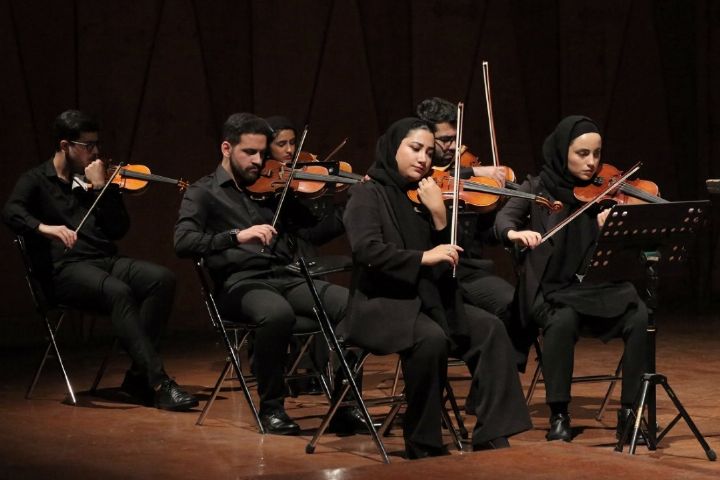
In a heartfelt return to the stage, the National Orchestra of Iran, conducted by Homayoun Rahimian, presented its second performance of the year with vocalist Hessamoddin Seraj in a concert titled “Mah-e Man” (My Moon), blending revered Persian poetry and classical melodies with a mix of vocal and instrumental pieces that reflected both the ensemble’s growing precision and its lingering challenges in cohesion and balance.
On the 10th and May 31 and June 1, 2024, Roudaki Hall hosted a performance by the Mitra Chamber String Orchestra — an ensemble backed by the private sector, aiming to bring together young musicians and offer audiences a glimpse into the collaborative experience of talented youth.
The orchestra presented a repertoire that included Bijan and Manijeh Suite by Hossein Dehlavi, Violin Concerto in A Minor by J.S. Bach, Solouan’s Song by Arvo Pärt, Nostalgia by Mehran Rouhani, and Simple Symphony by Benjamin Britten. Mohammadreza Safavi stood on the podium as conductor for both evenings.
The concert opened with Dehlavi’s Bijan and Manijeh, where the orchestra delivered a solid interpretation of the pizzicato opening. However, throughout the performance, the sonority was occasionally weak, with moments of intonation issues. There were also rhythmic mismatches during staccato passages, which clearer conducting gestures could have helped correct. Most sound issues appeared in the softer dynamics and slower tempos, while the orchestra performed with more confidence and clarity in louder and faster sections.
In Bach’s Violin Concerto, soloist Shakiba Khosravi gave a commendable performance. While she showed some uncertainty in certain notes, her execution of intervallic leaps was clean and precise. However, a few connected passages lacked clarity. Nonetheless, she maintained rhythmic unity with the orchestra and brought the piece to a coherent close.
The orchestra’s weakest performance came during Mehran Rouhani’s Nostalgia. Intonation issues were more prevalent than in other pieces, and the ensemble suffered from blurred sonority and rhythmic disunity. At times, particularly in the cello section, the sound quality became unpleasant, revealing the ensemble’s lack of readiness for this composition — though they managed to reach the end.
Regarding the conductor’s role, Mohammadreza Safavi can be described as someone who operates “on the edge” — executing the general expectations of a conductor adequately, but falling short in the critical nuances. For instance, in several pieces, the orchestra didn’t begin precisely together, which could have been avoided with clearer upbeat cues. More crucially, a conductor’s role extends beyond the concert itself, including rehearsals — guiding the orchestra based on the musicians’ abilities to achieve the best possible outcome, and using technical strategies to minimize errors in live performance.
It was evident that little attention had been paid to coordinating the vibrato among string players, each of whom applied it according to personal taste — a point that underscores the idea that a conductor must be far more than just a “live metronome.”
Mitra Orchestra is a thoughtful, talent-rich ensemble supported by the private sector. There’s no doubt that private organizations play an essential role in promoting and sustaining classical music in Iran. With the right management and artistic vision, this orchestra has the potential to continue progressing powerfully along its forward path.
Written By Farid Parish
